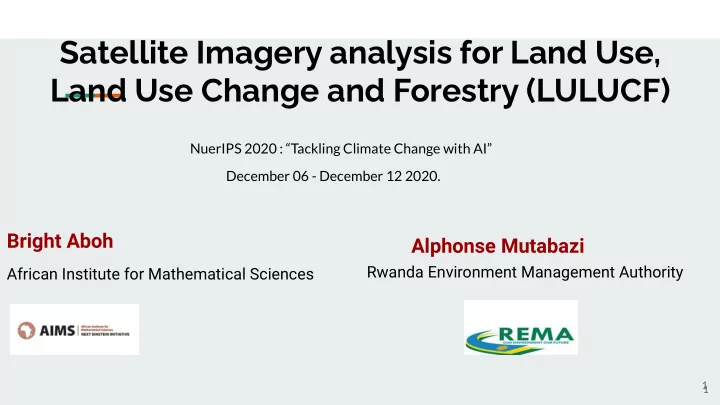

Satellite Imagery analysis for Land Use, Land Use Change and Forestry (LULUCF) NuerIPS 2020 : “Tackling Climate Change with AI” December 06 - December 12 2020. Bright Aboh Alphonse Mutabazi Rwanda Environment Management Authority African Institute for Mathematical Sciences 1 1
Introduction Human enhanced Greenhouse effects prevents sun rays from escaping into the atmosphere, leading to; More re-emitted heat to the earth ● Global warming and its effects ● 2
The Problem The main challenge facing many developing countries is the unavailability of activity data to be use in the calculation of greenhouse gas inventories; it is even more challenging in the Agriculture, Forestry and Other Land Use (AFOLU) sector since there are no proper documentation. 3 3
GHGs from the AFOLU sector The Agriculture, Forestry and Other Land Use (AFOLU) is the only sector that involves the release and(or) the uptake of Greenhouse gases; Forestry is the main sink ● Other activities on the land are ● the sources 4 4
The Goal The goal is to provide activity data on Land Use and Land Use Change towards the calculation of greenhouse gas emission from the AFOLU sector. Emission = Activity data X Emission factor. 5 5
Methodology Collect and analyse satellite imagery on various land use forms ● Using ground data (with labels) as reference , we pass them through Machine Learning algorithm ● to; a) Calculate the areas associated with each land type b) Calculate the land use change matrix c) Draw a land cover map for the country Imagery collection period: 2006-2019 6 6
Area of study 7
Machine Learning(ML) workflow in imagery 1. Operational Land Imager(OLI) and Thermal Infrared Sensors(TIS) for Earth (land) images 2. Label data on each of the six land types with their coordinate systems 8 8
Sample imagery Land cover with control points Land use change with control points 9
Imagery band selection Sensors on earth observing satellites measures the amount of electromagnetic radiation (EMR) that is reflected or emitted from the Earth’s surface These multispectral sensors, measures data in multiple regions of the electromagnetic spectrum ● The range of the electromagnetic wavelengths measured by sensors is known as the band ● 10
Imagery bands The band selection and (or) the ● various combinations is dependent on the kind of application or use case 11
Machine Learning Classification techniques: In land use applications, the purpose of classification is commonly to reveal the spatial distribution of various land use forms. 12 12
Machine Learning There are two types of ML classification techniques used with satellite imageries Pixel based classification ● Individual pixel images are analysed based on the spectral information they contain Object based image analysis ● A combination of spectral, textural and contextual information to identify thematic classes in images. 13
ML implementation with satellite imagery These steps lead to the machine learning implementation of our land use classification and quantification; Load cloud free imageries ● Define the bands (combination) to be used ● Overlay the points (with labels) on the imagery ● Split data ● Train a classifier ● Quantify each land type using their pixel counts ● 14
Result of the pilot study(Kigali) The results showed much improvement using the Classification and Regression Trees(CART) and RandomForest(RF) ML algorithms. Our model accuracies were 97% for CART and 95% for RF . 15 15
Land classification error & Land Use matrix_Kigali Overall validity of our classification together with the classification errors (in red ) are on the right. Land use and their conversion are on the left; quantified in hectares . 16 16
Land cover map classified 17 17
Impact Extraction of Activity data for the estimation of greenhouse gases from the AFOLU sector ● Improvement in the Tier levels (from Tier 1 to Tier 2) used for greenhouse estimations ● Contributing to sustainability of Land Use and Land Use Change monitoring systems in Rwanda ● 18 18
Some references ● Abdulhakim Mohamed Abdi. 2020. Land cover and land use classification performance of machine learning algorithms in a boreal landscape using Sentinel-2data.GIScience & Remote Sensing 57, 1 (2020),1–20 Simon Eggleston, Leandro Buendia, Kyoko Miwa, Todd Ngara, and Kiyoto Tanabe.2006.2006 IPCC guidelines for national ● greenhouse gas inventories. Vol. 5. Institute for Global Environmental Strategies Hayama, Japan ● Leo Breiman. 2001. Random forests.Machine learning 45, 1 (2001), 5–32 ● INTERGOVERNMENTAL PANEL ON CLIMATE CHANGE. 2003. Revision of the“Revised 1996 IPCC Guidelines for National Greenhouse Gas Inventories. (2003) ● ● Jean Nduwamungu, Elias Nyandwi, Jean Damascene, Theodomir Mugiraneza,Adrie Mukashema, Ernest Uwayezu, Rwanyiziri Gaspard, and Nzabanita Vital. 2013. RWANDA FOREST COVER MAPPING USING HIGH RESOLUTION AERIAL PHOTOGRAPHS 1. Link to paper : https://doi.org/10.1145/3378393.3402268 19
THANK YOU 20
Recommend
More recommend